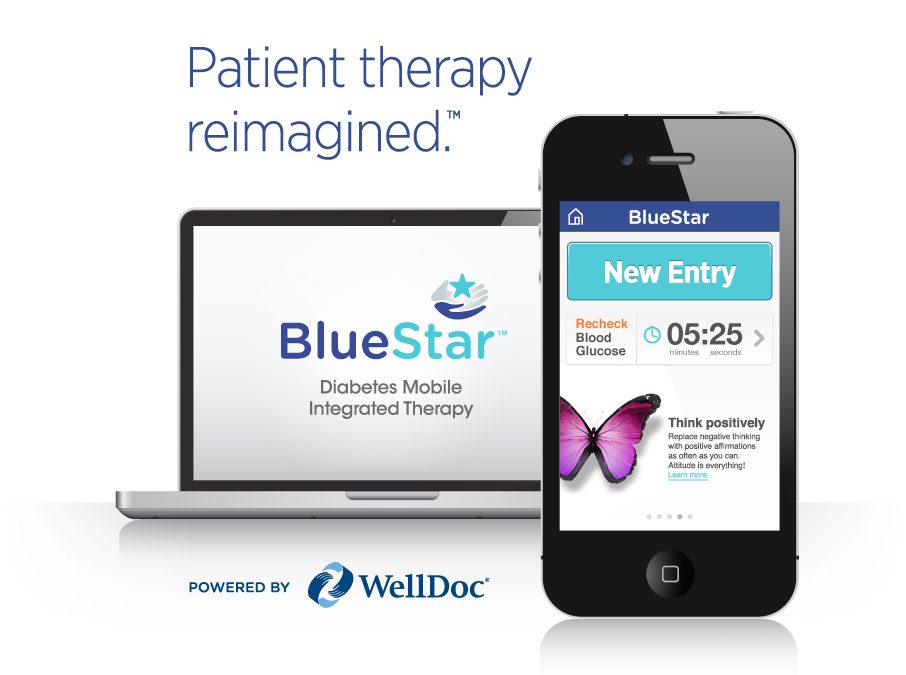BlueStar Diabetes Management System

BlueStar Diabetes Management System
What is it? WellDoc’s BlueStar Diabetes Management System (BlueStar DMS) is one of WellDoc’s interactive management programs on a mobile platform which supports and manages chronic type 2 diabetes. WellDoc also provides mobile based support for other chronic diseases such as cancer, cardiovascular diseases, mental health diseases etc., however BlueStar DMS is its only mobile management system that is currently an FDA Health IT services provided: Personalized healthcare and ubiquitous chronic disease management on everyday technologies like internet and mobile phones. It also provides chronic disease decision support tools, a virtual patient coach that supports patients anywhere as well as serves as an expert system for patients. More like having a regular doctor’s visit on the go. Current Status: BlueStar DMS has been a huge success story. In June of 2013, WellDoc received FDA clearance for the app to be prescribed for patients. This means that using this app, just like medical devices and medication not only will be available via prescription but also reimbursed. According to an article written by in Forbes Magazine, WellDoc raised $20 million from both the Merck Global health Innovation Fund and Windham Venture in order to market BlueStar. There have been other donations received from stakeholders and other interested companies. It is currently on the market as provides a personalized healthcare and management for diabetes people. Analysis of BlueStar System Design: WellDoc’s design of the BlueStar DMS was well thought through. In line with any system development as a solution to a problem like this, they realized a problem; finding a better solution to chronic healthcare management that is purely user-paced and ubiquitous. From what we know, they quickly figured out who else was interested, involved and/or related (directly or indirectly) to this problem. This is what is known as feasibility analysis and stakeholder identification. WellDoc decided to find all the things that could help them find a better solution to this problem. From their website, it is evident that they clearly set their goals straight. They gathered some information on who their possible and potential stakeholders will be. Their identified stakeholders are varied, have different interests and different needs. WellDoc however provides a customized approach and implementation training for them all. According to their business goals stated on their websites, they have design teams that are able to do the following for their clients; coordinate multi-party deals, do testing, develop on both mobile and other platforms, manage care process and design a usercentered solution and how to work with regulator bodies that are involved with healthcare devices standardization and other issues. BlueStar is supposed to manage care for diabetes populations when they are away from their provider or away from a healthcare facility. What this means that the system designed should have minimum supervision but the maximum support a patient can get in order to successfully manage their care. If there is a glitch in the system, BlueStar has a help/support functionality that helps patients to rectify issues. Conclusions: What WellDoc did well was find a need, find how to meet the need and give support while meeting the need. BlueStar has a multi-dimensional system that needed the expertise of healthcare, technology and UX/UCD. Healthcare expertise because BlueStar would be giving care support and management for chronic diabetes. It had to know the
domain for chronic diseases, what care was needed and how to at least replicate the care that the current healthcare system was giving. These healthcare experts were also to help better the management and care support that would be given considering that patients would need such support and care outside healthcare facilities. Technology expertise because the management system was going to be housed on a mobile- based platform. There needed to be technical infrastructure in place besides the software development of the management system. Finally they needed UX/UCD expertise because they needed a carefully thought of system with users’ needs as the central goal. In order to provide personalized care, users will need to be able to access, navigate and be satisfied with using BlueStar. For a system that is used by millions of people. The impact and implications of design are high.


